April 23, 2013
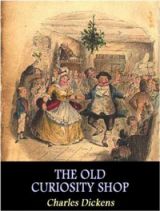 Hey, readers of this blog, you should know this: I’m a big fan of Charles Dickens. Heck, there are a couple Charles Dickens Cocktail Talk posts on here already (as well as a few other odds and sods related to him). He had the stuff, in my opinion. And, so I regularly re-read him, and recently did such with The Old Curiosity Shop. Not my top Dickens pick – not sure what is, really – but still awesomely awesome (I wonder what he would say if someone referred to him that way, way back when). And full of the lovely cast of Dickensian characters, good, bad, really bad, silly, stupid, wonderful, and tipsy. Of course, the latter are what we’re focusing on here. And the book is so filled with good drinkerly quotes that we’re gonna do a whole week of them! Or more. Who knows? Only me, Dickens, and the pony. This first quote’s from the early parts of the book, and makes some true points on soda water and human hair.
Hey, readers of this blog, you should know this: I’m a big fan of Charles Dickens. Heck, there are a couple Charles Dickens Cocktail Talk posts on here already (as well as a few other odds and sods related to him). He had the stuff, in my opinion. And, so I regularly re-read him, and recently did such with The Old Curiosity Shop. Not my top Dickens pick – not sure what is, really – but still awesomely awesome (I wonder what he would say if someone referred to him that way, way back when). And full of the lovely cast of Dickensian characters, good, bad, really bad, silly, stupid, wonderful, and tipsy. Of course, the latter are what we’re focusing on here. And the book is so filled with good drinkerly quotes that we’re gonna do a whole week of them! Or more. Who knows? Only me, Dickens, and the pony. This first quote’s from the early parts of the book, and makes some true points on soda water and human hair.
He began by remarking that soda-water, though a good thing in the abstract was apt to lie cold upon the stomach unless qualified with ginger, or a small infusion of brandy, which latter article he held to be preferable in all cases, saving for the one consideration of expense. Nobody venturing to dispute these positions, he proceeded to observe that the human hair was a great retainer of tobacco-smoke, and that the young gentlemen of Westminster and Eton, after eating vast quantities of apples to conceal any scent of cigars from their anxious friends, were usually detected in consequence of their heads possessing this remarkable property.
–Charles Dickens, The Old Curiosity Shop
December 12, 2012
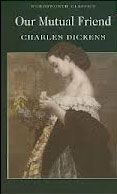 If I could, through the wonders of wondrous science (c’mon science, I’m buttering you up, make this happen) either go back in time to have a drink with Mr. Charles Dickens, or go miraculously into the universe of a Dickens’ book, well, I’d be tickled. Sure, sure, I wouldn’t want to go forever (I mean, Sookie and Rory wouldn’t be around, for one. And Dr. Strange wasn’t even a thought yet), but the pub and bar scenes he relates, and his evident adoration for certain drinks, call out to me in a slightly slurred voices. And if I had to choose which of the many watering holes from the many Dickens’ books? Well, I’m not sure, but the Six Jolly Fellowship Porters from the great book Our Mutual Friend would definitely be in the running, if not running away with my vote and me. Wonder why? Read the below quote why dontcha.
If I could, through the wonders of wondrous science (c’mon science, I’m buttering you up, make this happen) either go back in time to have a drink with Mr. Charles Dickens, or go miraculously into the universe of a Dickens’ book, well, I’d be tickled. Sure, sure, I wouldn’t want to go forever (I mean, Sookie and Rory wouldn’t be around, for one. And Dr. Strange wasn’t even a thought yet), but the pub and bar scenes he relates, and his evident adoration for certain drinks, call out to me in a slightly slurred voices. And if I had to choose which of the many watering holes from the many Dickens’ books? Well, I’m not sure, but the Six Jolly Fellowship Porters from the great book Our Mutual Friend would definitely be in the running, if not running away with my vote and me. Wonder why? Read the below quote why dontcha.
The bar of the Six Jolly Fellowship Porters was a bar to soften the human breast. The available space in it was not much larger than a hackney-coach; but no one could have wished the bar bigger, that space was so girt in by corpulent little casks, and by cordial-bottles radiant with fictitious grapes in bunches, and by lemons in nets, and by biscuits in baskets, and by the polite beer-pulls that made low bows when customers were served with beer, and by the cheese in a snug corner, and by the landlady’s own small table in a snugger corner near the fire, with the cloth everlastingly laid. This haven was divided from the rough world by a glass partition and a half-door, with a leaden sill upon it for the convenience of resting your liquor; but, over this half-door the bar’s snugness so gushed forth that, albeit customers drank there standing, in a dark and draughty passage where they were shouldered by other customers passing in and out, they always appeared to drink under an enchanting delusion that they were in the bar itself.
For the rest, both the tap and parlour of the Six Jolly Fellowship Porters gave upon the river, and had red curtains matching the noses of the regular customers, and were provided with comfortable fireside tin utensils, like models of sugar-loaf hats, made in that shape that they might, with their pointed ends, seek out for themselves glowing nooks in the depths of the red coals, when they mulled your ale, or heated for you those delectable drinks, Purl, Flip, and Dog’s Nose. The first of these humming compounds was a speciality of the Porters, which, through an inscription on its door-posts, gently appealed to your feelings as, ‘The Early Purl House’. For, it would seem that Purl must always be taken early; though whether for any more distinctly stomachic reason than that, as the early bird catches the worm, so the early purl catches the customer, cannot here be resolved. It only remains to add that in the handle of the flat iron, and opposite the bar, was a very little room like a three-cornered hat, into which no direct ray of sun, moon, or star, ever penetrated, but which was superstitiously regarded as a sanctuary replete with comfort and retirement by gaslight, and on the door of which was therefore painted its alluring name: Cosy.
—Our Mutual Friend, Charles Dickens
Tags: Bars, Charles Dickens, Cocktail Talk, Dog's Nose, Flip, Our Mutual Friend, Purl, Six Jolly Fellowship Porters, time travel to visit bars from the past
Posted in: Bars, Cocktail Talk, Drinking Writer
June 25, 2012
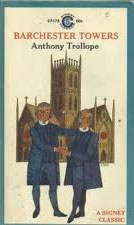 Barchester Towers (which has had a Cocktail Talk entry already) is of course the best known book by Anthony Trollope. Well, at least I believe it is. You can disagree if you’d like–I won’t hoot about it if you have a different favorite or think another of his remarkable novels has more reknown. If you don’t know who Anthony Trollope is, then, well, I don’t think you’re human. Heck, I’ve written a whole slew of Anthony Trollope posts, so you should at least know him through this here blog (and if you don’t, well, I’m not going to hoot, but I am going to wonder what it is, exactly, that’s wrong with you). But that’s as much as I’m gonna stew about it, cause instead I want to get to this little quote that I love so well, cause it is a quote from one of the greatest authors containing a shout out to another great author (if you don’t know who the second is after reading the below quote, then really, go back to watching bad TV). Many authors (like many people in general–outside of rap stars, who give shout outs to tons of contemporaries, often) are afraid of this type of behavior. Not my man Trollope, though. So, check this out, and think about how giving props to those who may, actually, be in the same game as you isn’t a bad thing.
Barchester Towers (which has had a Cocktail Talk entry already) is of course the best known book by Anthony Trollope. Well, at least I believe it is. You can disagree if you’d like–I won’t hoot about it if you have a different favorite or think another of his remarkable novels has more reknown. If you don’t know who Anthony Trollope is, then, well, I don’t think you’re human. Heck, I’ve written a whole slew of Anthony Trollope posts, so you should at least know him through this here blog (and if you don’t, well, I’m not going to hoot, but I am going to wonder what it is, exactly, that’s wrong with you). But that’s as much as I’m gonna stew about it, cause instead I want to get to this little quote that I love so well, cause it is a quote from one of the greatest authors containing a shout out to another great author (if you don’t know who the second is after reading the below quote, then really, go back to watching bad TV). Many authors (like many people in general–outside of rap stars, who give shout outs to tons of contemporaries, often) are afraid of this type of behavior. Not my man Trollope, though. So, check this out, and think about how giving props to those who may, actually, be in the same game as you isn’t a bad thing.
The bishop did it, and a very pleasant day indeed he spent at Ullathorne. And when he got home, he had a glass of hot Negus in his wife’s sitting-room and read the last number of the Little Dorritt of the day with great inward satisfaction.
–Anthony Trollope, Barchester Towers
February 22, 2011
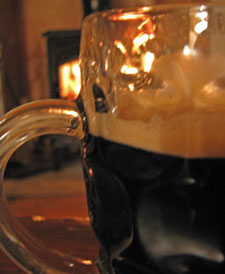 If you’ve read this blog longer than, well, last week, or have read any of my books, you probably know that I dig Dickens (Charles, that is. I don’t like Pudgie Dickens at all). I’ve had a quote or two on here from his books, and probably have rambled enough that if he were here, he’d say “shut yr yap Rathbun.” Or, he’d buy me a drink. I like Dickens so much that I even have posts about his up on other worthy blogs—well, at least one. See, I recently wrote about have drinks with Dickens on Michael Green’s blog. Head on over to learn more about drinks in Dickens time, why you should be toasting him, and how to make a few drinks mentioned in his book: the Dog’s Nose (pictured left) and the Purl. So, head on over and get your Dickens on.
If you’ve read this blog longer than, well, last week, or have read any of my books, you probably know that I dig Dickens (Charles, that is. I don’t like Pudgie Dickens at all). I’ve had a quote or two on here from his books, and probably have rambled enough that if he were here, he’d say “shut yr yap Rathbun.” Or, he’d buy me a drink. I like Dickens so much that I even have posts about his up on other worthy blogs—well, at least one. See, I recently wrote about have drinks with Dickens on Michael Green’s blog. Head on over to learn more about drinks in Dickens time, why you should be toasting him, and how to make a few drinks mentioned in his book: the Dog’s Nose (pictured left) and the Purl. So, head on over and get your Dickens on.
May 22, 2009
 Okay, I’m gonna come out and say it (cause it’s a Friday before a long holiday weekend, and I don’t have time for any dilly-dallying, and you don’t have time for me to go on along a long, literary, meandering, essay about it): Charles Dickens kicks ass. Hah, search and spam engines, chew on that. Dickens, even, kicks a mule’s ass. And if you’re from Kansas that’ll make some sort of sense. Or not. Dickens is not only one of the (probably the, but again, I’m not taking up too much of your time today) greatest novelists ever, but also enjoyed his pubs and pub-denizens, had a fine home stock of booze, and was known to take a sip or two regularly. Like all good-minded people.
Okay, I’m gonna come out and say it (cause it’s a Friday before a long holiday weekend, and I don’t have time for any dilly-dallying, and you don’t have time for me to go on along a long, literary, meandering, essay about it): Charles Dickens kicks ass. Hah, search and spam engines, chew on that. Dickens, even, kicks a mule’s ass. And if you’re from Kansas that’ll make some sort of sense. Or not. Dickens is not only one of the (probably the, but again, I’m not taking up too much of your time today) greatest novelists ever, but also enjoyed his pubs and pub-denizens, had a fine home stock of booze, and was known to take a sip or two regularly. Like all good-minded people.
Anywho, the following quotes are from the lesser-known (but genius) book Martin Chuzzlewit. I thought they might be a good prelude to your long weekend, help get you going with the right frame of drinking mind, and might, might I say, induce you to read a little, too, while kicking up your holiday heels. But avoid the dullness. Cause you aren’t ever dull. Not you.
As to them, the man who can dream such iced Champagne, such claret, port, or sherry, had better go to bed and stop there.
He could hang about a bar-room discussing the affairs of the nation, for twelve hours together; and in that time could hold forth with more intolerable dullness, chew more tobacco, some more tobacco, drink more rum-toddy, mint-julep, gin-sling, and cock-tail than any private gentleman of his acquaintance. This made him an orator and man of the people.
—Charles Dickens, Martin Chuzzlewit
October 9, 2008
Much like it’s easy to get caught up in the day-to-day busy-ness of work and then put off a blog post for a week plus, a post that you’ve been meaning to write every day (but then the corporate hive masters crack their electronic whips over you like you’re a sled dog pulling their dollar-making sled along until you just can’t take it anymore and end up constructing an example like this one, with mixed metaphors and long clauses that go on like a particularly annoying work day), much like this in a really small way is how it’s easy to get caught up in the vast array of ciders and beers available in the smaller towns in the U.K., and forget that there are some tip top cocktail slingers there, too, and that London has a sparkling array of cocktail spots. Whew, after that sentence we all need a drink. If you’re reading this in London, I suggest you find that drink at the Lonsdale, which is the focus of U.K. Drinks: Part Two (if you missed Part One, follow the link or scroll on down).
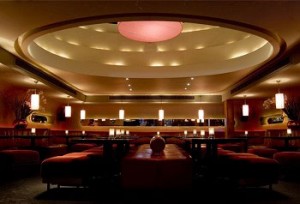
I was taken to the bar by cocktail-loving pals Ean and Reba (also known as Tales from the Birdbath), and accompanied by them and wife Natalie, but was given the suggestion of the Lonsdale as a tight cocktail spot by the fine writing-publishing folks Jared Brown and Anistatia R. Miller (who are also co-founders of the Museum of the American Cocktail). As a quick aside, if you haven’t picked up Mixologist: The Journal of the American Cocktail Volume I and Volume II, which they published, edited, and contributed to, then I’m not sure you can call yourself a cocktail lover, as these collections are bubbling over with essays from today’s top cocktailians about topics sure to wet your literary whistle. They’re also the authors of a range of books (from Champagne Cocktails to Shaken Not Stirred: A Celebration of the Martini). What I’m trying to get to in my roundabout way is that if they’re nice enough to suggest a spot for cocktails, it’s going to be reliably awesome. Which the Lonsdale was. The crowd may have been a bit stock-brokerish, and have wondered at my Mighty Boosh buttons, but the wait staff was sweet and the drinks were fantastic. I started with what I thought was a fairly under-utilized early-part-of-last-century-ish cocktail that I wasn’t sure was being poured today anywhere outside of my garage (I’d never had it outside of my garage at least. I had it first there when putting together Good Spirits), the Whizz Bang. From the Lonsdale’s in-depth and multi-page menu, I learned the drink was invented by Tommy Burton in 1920 at the Sport’s Club of London (I knew it was named after high-velocity shells in the war, due to the sounds they made). Here’s the picture (it was dark in there, so the photos aren’t the best) and the recipe.
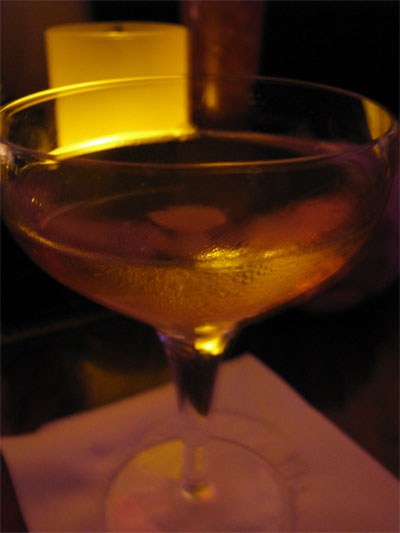
Ice cubes
1-3/4 ounces Baillie Nicol Jarvie Scotch
3/4 ounce Noilly Prat Dry Vermouth
1/4ish ounce absinthe
1/4ish ounce pomegranate syrup
1 dashes orange bitters
1. Fill a cocktail shaker halfway full with ice cubes. Add everything. Shake well. Strain. Serve.
In the past, I’d made my Whizz Bangs with bourbon and Pernod instead of scotch and absinthe (due to necessity until recently on the latter). But the scotch here gave it a polite backbone and light smoky undertone. It may have been one of the best drinks I’ve had out (okay, take this with a grain of “I’m given to large pronouncements and going overboard about oodles of things,” but wow, it was delish), with the balance of flavors and hints of absinthe peeking through like the last rays of sunlight before dusk.
This may seem like an odd move for a cocktailing evening, but for my second drink I went for a Pisco Sour. After the knock out success of the Whizz Bang, I thought it’d be fun to get a more recognized classic, and see how the bartenders (who, sadly, I didn’t get to meet, as the bar area was overtaken by some sort of bungling birthday party, with ridiculous revelers who weren’t even taking advantage of the bar’s white hot staff of shakers, instead drinking beer and causing enough of a traffic jam that trying to get to the bar would have been an ordeal taking far too much time away from drinking) served it up. And, they served it up on the edge of marvelously (in the way that Dombey & Son is marvelous. It’s so marvelous, but not quite as marvelous as Bleak House), with an almost too serious head frothed up, as you can see in the picture below. The Macchu Pisco was exquisite, and the balance of sour to smooth walked the line perfectly. It would have been hard to follow up the Whizz Bang for any drink, though.
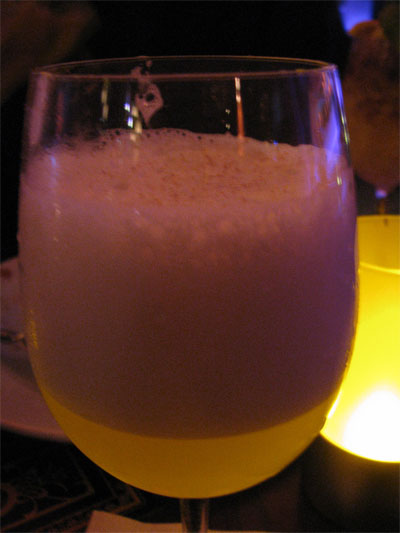
For my final drink of the evening, I went for a dessert number (and if anyone reading this wants to take offense with my dessert drink then fooey on you-y), a Coconut Flip, made with La Diablada Pisco (see, I was trying to follow a more natural path between drinks 2 and 3), Velvet Falernum (which I’ve been playing around with my-own-self recently), egg yolk, and sugar, with a touch of nutmeg on top in Flip style (a style which, the menu lets you know, traces back to pre-1810 England. They’re good country promoters at the Lonsdale). It was a great capper, with sweetness that didn’t overwhelm and a nice chewy (I’m not describing it exactly right, but it had a mouth feel that was more robust than most drinks due to the yolk) nature. By that time, I’d given up on taking snaps, due to lighting, but picture a smallish glass (a Delmonico glass, to be precise) of wet fluffy whiteness. Like a beautiful romantic ghost-in-a-glass, in a way. So, here’s to the Lonsdale, again, and to Ean and Reba again for taking us, with thanks for a delicious cocktail evening.
 Hey, readers of this blog, you should know this: I’m a big fan of Charles Dickens. Heck, there are a couple Charles Dickens Cocktail Talk posts on here already (as well as a few other odds and sods related to him). He had the stuff, in my opinion. And, so I regularly re-read him, and recently did such with The Old Curiosity Shop. Not my top Dickens pick – not sure what is, really – but still awesomely awesome (I wonder what he would say if someone referred to him that way, way back when). And full of the lovely cast of Dickensian characters, good, bad, really bad, silly, stupid, wonderful, and tipsy. Of course, the latter are what we’re focusing on here. And the book is so filled with good drinkerly quotes that we’re gonna do a whole week of them! Or more. Who knows? Only me, Dickens, and the pony. This first quote’s from the early parts of the book, and makes some true points on soda water and human hair.
Hey, readers of this blog, you should know this: I’m a big fan of Charles Dickens. Heck, there are a couple Charles Dickens Cocktail Talk posts on here already (as well as a few other odds and sods related to him). He had the stuff, in my opinion. And, so I regularly re-read him, and recently did such with The Old Curiosity Shop. Not my top Dickens pick – not sure what is, really – but still awesomely awesome (I wonder what he would say if someone referred to him that way, way back when). And full of the lovely cast of Dickensian characters, good, bad, really bad, silly, stupid, wonderful, and tipsy. Of course, the latter are what we’re focusing on here. And the book is so filled with good drinkerly quotes that we’re gonna do a whole week of them! Or more. Who knows? Only me, Dickens, and the pony. This first quote’s from the early parts of the book, and makes some true points on soda water and human hair.



























